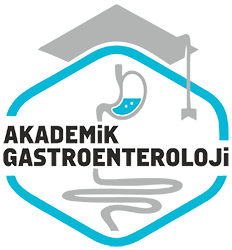Skuamokolumnar bileskede inflamasyon ve intestinal metaplazi: Helicobacter pylori infeksiyonunun rolü
Inflamation and intestinal metaplasia in the squamocolumnar junction: The role of Helicobacter pylori infection
- Ana Sayfa
- Sayılar
- Skuamokolumnar bileskede inflamasyon ve intestinal metaplazi: Helicobacter pylori infeksiyonunun rolü...
Özet
Giriş ve amaç: Bati ülkelerinde Helicobacter pylori (Hp) prevalansinin azalmasi ile birlikte, özofagus ve kardiya adenokarsinomalarinin insidansi nda artis olduğu bildirilmektedir. Türkiye’de yetiskin popülasyonda Hp pozitifliği halen %75’in üzerindedir. Klasik Barrett özofagusu bulunmayan hastalarda, gastroözofageal bileskedeki adenokarsinomalarin, gastroskopiye giren Hastaların % 9-36’sinda saptanan, skuamokolumnar bileskedeki intestinal metaplazi (IM) odaklarindan köken aldiklari görülmektedir. IM’nin, kronik inflamasyonun bir sonucu olduğu var sayılmaktadi r. Skuamokolumnar bileske (SKB)’deki IM’de, bu bölgedeki inflamasyon gibi, Hp veya gastroözofageal reflü hastalığı ile ilişkilidir. Bu çalışmanın amacı, SKB’deki inflamasyon ve IM’nin, Hp pozitifliği yüksek olan bir popülasyonda arastirilmasi; sözkonusu bakteri ile multipl endoskopik biyopsi örnekleri alinarak olasi korelasyonlarini belirlemektir. Gereç ve yöntem: Bu çalışmada, özofagogastroduodenoskopi için basvuran 38 hastada (30 erkek, 8 kadın) gastrik fundus, korpus, antrum, postbulber bölge, SKB ve özofagustan endoskopik biyopsiler alındı. Biyopsi örnekleri tek bir patolog tarafindan inflamasyon, aktivite, atrofi varligi, gastrik ve kardiyak IM açısından değerlendirildi. Bulgular: Sonuçta çalışma grubunda 36 gastrit hastasınin 29’unda kronik Hp gastriti; 38 hastanın 28’inde (% 73.5) histolojik özofajit; 38 hastanın 37’sinde (%97) SKB’de inflamasyon, 5’inde (%13) IM (4’ü komplet, 1’i inkomplet) saptandi. Fundus, korpus ve antrumdaki inflamasyon ve aktivite arasında anlamli korelasyon saptandi (p<0.05). SKB’nin kolumnar tarafi ndan alinan biyopsilerin 24’ü oksintik, 12’si kardiyak, 1’i skuamoz mukoza idi. Oksintik ve kardiyak mukoza saptanan Hastaların karsilasti- rilmasinda birinci gruptaki Hastaların yaş ortalaması, ikinci gruptaki hastalari n yaş ortalamasından anlamli olarak daha küçüktü (p<0.01). Sonuç: Bu çalışmada, Hp prevalansinin yüksek olduğu bir popülasyonda gastrik kardiyadaki inflamasyon ve IM’nin sözkonusu bakterinin yol açtigi kronik gastritle ilişkili olduğunu; fakat adenokarsinomayla beraberligi sik olmayan komplet tipte IM’nin gözlendigini ortaya koyduk.
Abstract
Background/aim: It is reported that the incidence of adenocarcinoma of the cardia and esophagus has increased in western countries simultaneously with a decrease in Helicobacter pylori (Hp) prevalence. In Turkey, Hp positivity is still above 75% in the adult population. In patients without classic Barrett’s esophagus, adenocarcinomas of the gastroesophageal junction appear to arise from foci of intestinal metaplasia (IM) at the squamocolumnar junction (SCJ), which occur in 9-36% of patients undergoing gastroscopy. IM is assumed to be a consequence of chronic inflammation. Like inflammation at the SCJ, IM at the cardia has also been associated either with Hp gastritis or with gastroesophageal reflux disease. The aim of this study was detection of IM and inflammation at SCJ in a population with high Hp positivity, by multiple biopsy specimens, and definition of probable correlations. Materials and methods: In this study, endoscopic biopsy specimens were taken from 38 patients (30 male, 8 female) who presented for esophagogastroduodenoscopy (from gastric fundus, corpus, antrum, second portion of duodenum, SCJ, esophagus). Biopsy specimens were examined by one pathologist for inflammation, activity, and presence of atrophy and gastric-cardiac IM. Results: Chronic Hp gastritis was detected in 29 of 36 patients with gastritis; histologic esophagitis in 28 of 38 patients (73.5%); inflammation at SCJ in 37 of 38 patients (97%); and IM at SCJ in 5 of 38 patients (13%)(4 complete, 1 incomplete). A significant correlation was detected between inflammation and activity in fundus, corpus and antrum (p<0.05). Biopsy specimens taken from the columnar side of the SCJ were oxyntic in 24, cardiac in 12, and squamous in 1. Comparison of the patients detected to have oxyntic and cardiac mucosa revealed that the mean age of the patients in the first group was significantly lower than that of the second group (p<0.01). Conclusion: We have shown, in a population with high Hp prevalence, a correlation between inflammation at the gastric cardia and IM with chronic gastritis caused by the aforementioned bacterium; but put forward complete type IM, which is infrequently associated with adenocarcinoma, has been seen.



